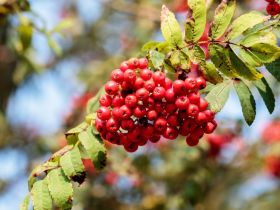Rowan (Mountain Ash)
The rowan tree, sometimes known as a mountain ash, is one of the most popular of all the trees that are native to the UK. In the British Isles it has long been used as both an ornamental and useful tree – having been used in the past to provide the berries for medicinal or culinary uses and wood for woodworking. As many people will already be aware, the rowan also has mythological connotations and was used to protect homesteads and church yards. Its wood was used to make many luck-bringing and prosthetic items. For some, the rowan retains its more mystical elements to this day. It has pretty white blossoms in spring and glorious red berries that bring a touch of colour at harvest time and in early autumn.
Growing rowan trees:
While it is possible and relatively easy to grow rowan trees from seed, this fiddly and very time consuming process is not usually undertaken by the home gardener. Instead, it is more usual to buy a one or two year old tree from a garden centre or nursery. If you do want to sow your own seed you will have to collect the berries in late August to mid-September and carefully extract the seeds by mashing the berries gently allowing seeds to fall down through a mesh. Then you can sow the seeds in pots with half and half compost or leaf mould, and horticultural sand – these pots must be kept moist and away from rodent and bird robbers, though they have to spend the winter outside. When the seeds start to germinate in the spring then you can sow them four to a litre pot. Water well. Remove weakest saplings until only one remains per pot. After a year or two your baby tree will finally be ready to plant out.
When planting out a young rowan in your garden, dig a hole big enough to accommodate the root ball and be sure to replant it to the same depth that it was at previously. You should ensure that grass and weeds are not crowding round your sapling, as these will compete for nutrients with the young tree.
Rowan trees like a loam or sandy soil that is well drained and neutral or slightly acidic. They like full sun but can be equally content in partial shade. They could be a good addition to pretty much any garden as they can cope with some pretty tough conditions (as they do in the Scottish Highlands, where they grow in profusion).
Why grow a rowan tree in the garden?
Rowan trees are perfect for low maintenance gardens with plenty of wildlife. Birds will eat the berries and other creatures will also reap the bounty. They give a burst of colour and a pleasing shape to delight the eye, and if you are keen on growing your own, rowan berries can also be used to make a range of drinks and condiments (though they cannot be eaten raw).
Remember also that planting a beautiful rowan in your garden will protect you and your loved ones from harm and bring good luck.

